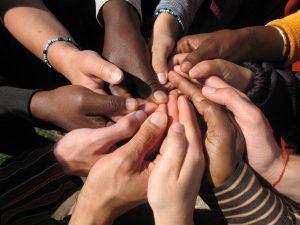The experience of space and the boundaries it has raised have made us rethink and reimagine opposites. With our project INTERSPACE we would like to encourage exchange. Furthermore, borders need to be broken in order to playfully enter into exchange. Closeness and distance, experiencing spaces in full reception and thinking beyond. Our exit strategy is a beginning to move and interact in new spaces.
During our research on the topic of living space and alternative supply structures (organic food, food sharing, permaculture…) it became more and more clear to us how comprehensively this field touches all other problematic areas (such as education, nutrition, climate…) and we moved from a bird’s eye view to a closer look at the space as such. More and more the idea emerged to use the potential of change that lies in the form of an intervention.
We now want to create a temporary space of experience, a space of imagination that could lead to a different, more conscious and supportive way of living together. This experiential space is to be created as an intervention in public space and provide an occasion for an exchange on how space could be designed, lived and enlivened. Above all, the aspect of participation is very important to us, since the joint activity or use of the installation, brings people together almost automatically on one level and thus directly a fruitful space for discussion can arise.
The installation will be mobile, so it can be installed in different places. It will be thick, organic-looking ropes hanging from a metal framework. The ropes are looped around the struts of the scaffolding with a knot and hang loosely down to the ground. The somewhat strangely curved greenish ropes, which are reminiscent of a fleshy plant or aerial roots, are intended to arouse the curiosity of passers-by and invite them to interact. The ropes can be knotted, for example, to form small and also larger seating levels and swings, and thus the space around the ropes is in constant flux. Also due to the openness to all sides, the installation is constantly influenced by wind and weather and keeps changing. It is a large network of knots to which everyone can connect. This joint creation and linking of a space can give impulses for an expanded perception of space and its design possibilities.
Viewed in a larger context, this playful approach should also lead to a questioning of our fixed ideas/images of historically grown cities and to thinking about a new space in between. A space of exchange, mutual support and shared experience. We want to create an interface of urban/artificial space, natural space and social space. In a way, the installation is meant to stand as a metaphor for an abundance and a density (of the city) and to invite to deal with this abundance, to order it and to create new space. The interaction can be seen as a playful exercise of how we might deal with our living space, leading to an invention of possible futures (in the dimensions of social and educational).
Initially, a small model of the installation exists, but we also set our sights on a possible location in Berlin, namely the old Hammelhalle near Storkower Straße. The scaffolding of the old Hammelhalle could be the perfect support for the ropes of the installation. By working with the already existing construction, the installation would be realizable with very simple means. An opening of the installation is planned as well as regular events to give concrete food for thought for the conscious interaction with the installation. These thought-provoking impulses could, for example, take the form of a performance that illustrates the possible shared spaces of experience or brings them to life. Also conceivable is a certain coloring of the ropes, divided into several color groups, which provide a clue for possible connections over long distances and make it clear that the space can only be created in conjunction with several people.
A concept by Marc Roman Page, Devi Sofia Sund Rojo and Natalie Marie Preuß
 GEN is composed of 5
GEN is composed of 5